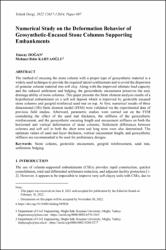Numerical Study on the Deformation Behavior of Geosynthetic-Encased Stone Columns Supporting Embankments
Citation
Kahyaoğlu M. R. , Doğan T. Numerical Study on the Deformation Behavior of Geosynthetic-Encased Stone Columns Supporting Embankments. Teknik Dergi. 2022; 33(5): 12617-12634.Abstract
The method of encasing the stone column with a proper type of geosynthetic material is a widely used technique to provide the required lateral confinement and to avoid the dispersion of granular column material into soft clay. Along with the improved ultimate load capacity and the reduced settlement and bulging, the geosynthetic encasement preserves the easy drainage ability of stone columns. This paper presents the finite element analysis results of a hypothetical embankment on a soft soil deposit which is improved by geotextile encased stone columns and geogrid reinforced sand mat on top. At first, numerical results of three dimensional (3D) finite element model (FEM) were validated via the experimental data of previous field studies. Afterward, parametric studies were carried out on the FEM considering the effect of the sand mat thickness, the stiffness of the geosynthetic reinforcement, and the geosynthetic encasing length and encasement stiffness on both the horizontal and vertical deformation of stone columns. Settlement differences between columns and soft soil in both the short term and long term were also determined. The optimum values of sand mat layer thickness, vertical encasement length, and geosynthetic stiffness are recommended to be used for preliminary designs.


















